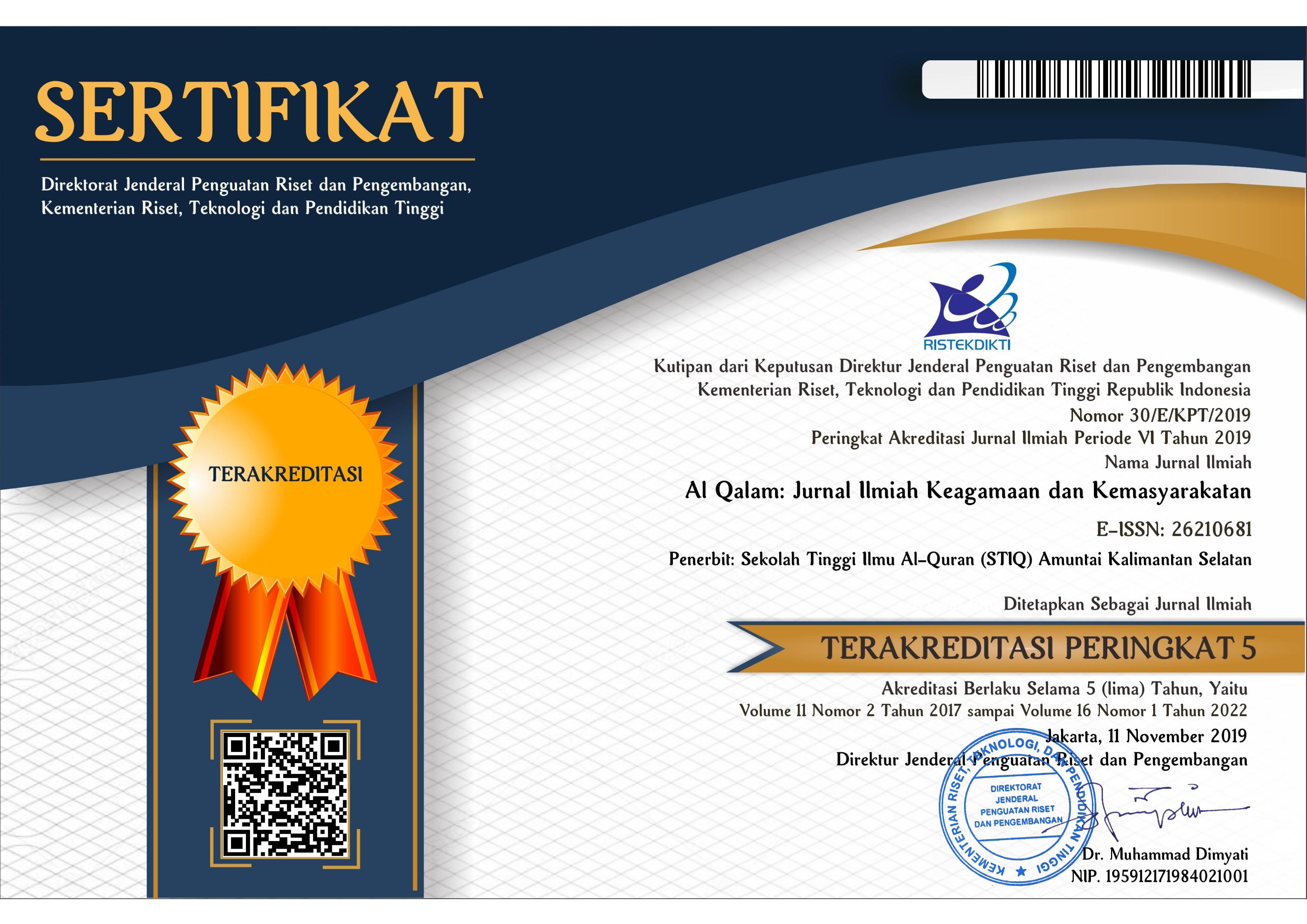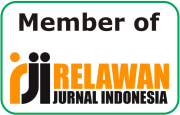Semantic Analysis of the Synonymity of the Meaning of Khatama and Ṭaba'a in the Quran: Contextual Relevance for Contemporary Interpretation Studies
Abstract
The synonymy of meaning between the words khatama and ṭaba'a in the Qur'an has become an important issue in semantic and exegesis studies. These two words are often understood to have similar meanings, namely to close, but have different contextual nuances. This study aims to analyze the semantic differences between khatama and ṭaba'a, and evaluate their relevance in the context of contemporary exegesis. The method used is a qualitative method with semantic-comparative analysis techniques. The results of the study show that khatama tends to be used to describe God's action in closing the heart permanently as a consequence of rejecting the truth, while ṭaba'a is more of a locking action that is oriented towards cause and effect. In the context of contemporary exegesis, this difference is relevant to understanding the dynamics of guidance and rejection of the truth in modern society. In conclusion, khatama and ṭaba'a are not entirely synonymous, but rather have specific contextual meanings. This study makes an important contribution in deepening the study of the semantics of the Qur'an and enriching the interpretation of exegesis with a contextual approach.
Keywords
Full Text:
PDFReferences
Admizal, Iril. “Study of the Word Rahmah in the Context of Giving Grace to Prophets and Apostles.” Ishlah: Journal of Ushuluddin, Adab and Dakwah 5, no. 1 (2023): 145–58. https://doi.org/10.32939/ishlah.v5i1.242.
Ahmadi, Ahmadi. “جوهر علم الدلالة في القرآن (دراسة تحليلية دلالية في قراءة الآيات القرآنية).” LISANIA: Journal of Arabic Education and Literature 2, no. 2 (2018): 193. https://doi.org/10.18326/lisania.v2i2.193-215.
Al-Bagawī, Abū Muḥammad al-Ḥusain bin Mas'ūd bin Muḥammad bin al-Farā'. Ma'ālim Al-Tanzīl Fī Tafsīr Al-Qur'ān. Beirūt: Dār Iḥyā' al-Turāṡ al-'Arābī, 1999.
Al-Baiḍāwī, Nāṣr Al-Dīn Abū Sa'īd 'Abdullāh bin 'Umar bin Muḥammad Al-Syairāzī. Anwār Al-Tanzīl Wa Al-Asrār Wa Al-Ta'wīl. Beirūt: Dār Iḥyā' al-Turāṡ al-'Arābī, 1997.
Al-Bāqī, Muḥammad Fuād 'Abd. Al-Mu'Jam Al-Mufahras Li Alfāẓ Al-Qur'Ān Al-Karīm. Cairo: Dār al-Kutub al-Miṣriyyah, 1945.
Al-Jubouri, Muwaffaq Hussein Aliwi. “The Semantic Permission in Selected Poetic Evidences in Ibn Mandhur's Lisan Al-Arab (711 AH).” Journal of Language Studies 5, no. 4 (2022): 197–218. https://doi.org/10.25130/jls.5.4.1.16.
Al-Qurṭubī, Abū 'Abdillāh Muḥammad bin Aḥmad al-Anṣārī. Al-Jāmi' Li Aḥkām Al-Qur'ān. Edited by Aḥmad Al-Birdūnī and Ibrāhīm Aṭfīsy. Cairo: Dār al-Kutb al-Miṣriyyah, 1964.
Al-Sa'dī, 'Abdurraḥmān bin Nāṣr bin 'Abdullah. Taisīr Al-Karīm Al-Raḥmān Fī Tafsīr Kalām Al-Manān. Beirūt: Muassasah al-Risālah, 2000.
Al-Ṭabarī, Abū Ja'far Muḥammad bin Jarīr. Jāmi' Al-Bayān 'an Ta'Wīl Al-Qur'an. Cairo: Dār al-Hijr, 2001.
Al-Zuḥailī, Wahbah. Tafsīr Al-Munīr Fī Al-'Aqīdah Wa Al-Syarī'Ah Wa Al-Manhaj. Damascus: Dār al-Fikr, 2009.
Ali, Atabik, and Ahmad Zuhdi Muhdlor. Contemporary Arabic-Indonesian Dictionary. Yogyakarta: Multi Karya Grafika, 2003.
Alshammeri, Menwa, Eric Atwell, and Mhd ammar Alsalka. “Detecting Semantic-Based Similarity Between Verses of The Quran with Doc2vec.” Procedia Computer Science 189 (2021): 351–58. https://doi.org/10.1016/j.procs.2021.05.104.
Arrauf, Ismail Fahmi, and Miswari Miswari. “Capturing God’s Message: The Urgency of Contextualizing the Qur’an Through Hermeneutics.” Jurnal At-Tibyan: Jurnal Ilmu Alquran Dan Tafsir 3, no. 2 (2018): 223–36. https://doi.org/10.32505/tibyan.v3i2.698.
Beirade, Faiza, Hamid Azzoune, and D Eddine Zegour. “Semantic Query for Quranic Ontology.” Journal of King Saud University - Computer and Information Sciences 33, no. 6 (2021): 753–60. https://doi.org/https://doi.org/10.1016/j.jksuci.2019.04.005.
Bentrcia, Rahima, Samir Zidat, and Farhi Marir. "Extracting Semantic Relations from the Quranic Arabic Based on Arabic Conjunctive Patterns." Journal of King Saud University - Computer and Information Sciences 30, no. 3 (2018): 382–90. https://doi.org/10.1016/j.jksuci.2017.09.004.
Berkani, Abdelmalek, Adrian Holzer, and Kilian Stoffel. “Pattern Matching in Meter Detection of Arabic Classical Poetry.” In 2020 IEEE/ACS 17th International Conference on Computer Systems and Applications (AICCSA), 1–8, 2020. https://doi.org/10.1109/AICCSA50499.2020.9316497.
Chukhanov, Sansyzbay, and Nurlan Kairbekov. “The Importance of a Semantic Approach in Understanding the Texts of the Holy Quran and Sunnah.” Pharos Journal of Theology 105, no. 3 (2024): 1–11. https://doi.org/10.46222/pharosjot.105.36.
Fata, Badrus Samsul, and S Mahmudah Noorhayati. "Synonymity School (Al-Tarâduf) in 'Ulumul Qur'an." AL Fikrah: Journal of Islamic Thought and Education 2, no. 1 (2022): 26–40. https://doi.org/10.51476/alfikrah.v2i1.356.
Gatzka, Thomas. “Aspects of Openness as Predictors of Academic Achievement.” Personality and Individual Differences 170 (2021): 110422. https://doi.org/10.1016/j.paid.2020.110422.
Harahap, Alwi Padly, and Ari Mayang Wahyuni. “The Role of Women as Mufassir and Their Contribution to Islamic Education.” Ibn Abbas: Journal of Quranic Science and Tafsir 7, no. 1 (2024): 1–21. https://doi.org/10.51900/ias.v7i1.22548.
K, Agustang. “The Tradition of Khatam Qur'an as an Effort to Realize Islamic Character Education in Ternate City, North Maluku.” Foramadiahi: Journal of Islamic and Educational Studies 11, no. 1 (2019): 34. https://doi.org/10.46339/foramadiahi.v11i1.146.
Kaṡīr, Abū al-Fadā' Ismā'īl bin 'Umar bin. Tafsīr of the Koran Al-'Aẓīm. Edited by Abdul Ghoffar and Abu Ihsan Al-Atsari. Bogor: Imam ash-Shafi'i Library, 2004.
Leaman, Oliver. “Modern Developments in Qur'anic Studies.” Edited by Mustafa Shah and Muhammad Abdel Haleem. The Oxford Handbook of Qur'anic Studies. Oxford University Press, May 14, 2020. https://doi.org/10.1093/oxfordhb/9780199698646.013.42.
Masrukhin, Mohammad Yunus. "The Will And The Presence Of Human Being In Abu Al-Hasan Al-Ash'Ari'S Thought: Explaining the Relation between Human and God in Kalam Discourse." Al-Jami'ah 59, no. 1 (2021): 221–54. https://doi.org/10.14421/ajis.2021.591.221-254.
Miller, Jeannie. “Bayān, Gesture, and Genre: Self-Positioning in Al-Jurjānī's Introductions.” Journal of Abbasid Studies 5, no. 1–2 (2019): 58–104. https://doi.org/10.1163/22142371-12340038.
Nuraini, and Dhira Majid. “Lafaz Rahmah in the Quran.” Budapest International Research and Critics Institute-Journal (BIRCI-Journal) 4, no. 3 (2021): 5548–57. https://doi.org/10.33258/birci.v4i3.2351.
Perdana, Dyah Adila, and Umm Hanifah Syamsuhri. "Synonymity in the Qur'an: Lafadz Sanah and 'Am (Semantic Study)." Tarling : Journal of Language Education 6, no. 2 (2022): 275–90. https://doi.org/10.24090/tarling.v6i2.7192.
Rohman, Abdul, Muhammad Irfan, and Amin Amin. “Tracing the Meaning of the Word Nūr in the Qur'an: Encyclopedic Semantic Application.” Kawakib Journal 4, no. 2 (2024): 155–69. https://doi.org/10.24036/kwkib.v4i2.176.
Sawalha, Majdi, Faisal Al-Shargi, Sane Yagi, Abdallah T AlShdiafat, Bassam Hammo, Mariam Belajeed, and Lubna R Al-Ogaili. “Morphologically-Analyzed and Syntactically-Annotated Quran Dataset.” Data in Brief, 2024, 111211. https://doi.org/10.1016/j.dib.2024.111211.
Shihab, Quraish. Tafsir Al-Misbah: Message, Impression and Harmony of the Qur'an. Jakarta: Lentera Hati, 2010.
Soga, Zainuddin, Achmad Tola, Amrah Kasim, and Kamaluddin Abunawas. “The Application Of The Semiotics Of Qur'an Toward The Story Of The Chosen Servants In Surah Maryam.” Jurnal Diskursus Islam 9, no. 2 (2021): 320–35. https://doi.org/10.24252/JDI.V9I2.22868.
Susilawati, Ani, and Ahmad Habibi Syahid. “Synonyms of Arabic Words from the Translation of the Book Alfu Lailah Walailah Lilathfal (Contextual Semantic Approach).” Mantiqu Tayr: Journal of Arabic Language 4, no. 2 (2024): 426–44. https://doi.org/10.25217/mantiqutayr.v4i2.4608.
Sweta, Andri Arungga, Muhammad Hamzah Syubly bin Abd Hadi Kamil, Aman Ullah, and Nematullo Mukhamedov. "The Urgency of Siyaq (Interpretation of the Word Al-Ins and Basyar Perspective of Ar-Raghib Al-Ashfahani) in Buku Al-Mufrodat Fi Gharib Al-Qur'an." QiST: Journal of Quran and Tafseer Studies 1, no. 3 (2022): 329–42. https://doi.org/10.23917/qist.v1i3.2221.
Zellman, Ariel, and Jonathan Fox. "Defending the Faith? Assessing the Impact of State Religious Exclusivity on Territorial MID Initiation." Politics and Religion 13, no. 3 (2020): 465–91. https://doi.org/10.1017/S1755048319000488.
DOI: http://dx.doi.org/10.35931/aq.v19i3.4482
Refbacks
- There are currently no refbacks.
Copyright (c) 2025 Ramadhani Ramadhani, Ismail Fahmi Arrauf Nasution, Asrar Mabrur Faza, Armainingsih Armainingsih, Alwi Padly Harahap

This work is licensed under a Creative Commons Attribution 4.0 International License.
Al Qalam: Jurnal Ilmiah Keagamaan dan Kemasyarakatan
index by:
Publish by:
Sekolah Tinggi Ilmu Al-Qur'an Amuntai
Contact us:
Address: Jl. Rakha Pakapuran, Amuntai Utara
Kabupaten : Hulu Sungai Utara
Kode Pos : 71471
Provinsi : Kalimantan Selatan
Telephone : 085251613000
Email: hafizhihusinsungkar@gmail.com

This work is licensed under a Creative Commons Attribution 4.0 International License


